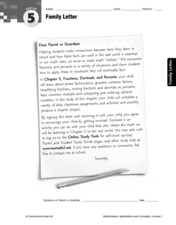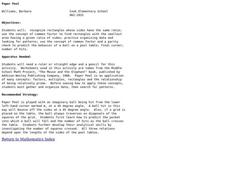Curated OER
Prime Factors
In this prime factors worksheet, students solve and complete 20 different problems related to prime factors of various numbers. They determine the factors for each given number by multiplying various numbers together to get another number.
California Academy of Science
Earthquakes and Tectonic Plates
Here is a comprehensive package in which middle schoolers learn about types of seismic waves, triangulation, and tectonic plate boundaries. Complete vocabulary, colorful maps, and a worksheet are included via links on the webpage. You...
Bowland
Pointzero: Confined
Groups plan their escape carefully. Three three-tiered puzzles help a story character escape their situation, each involving integer sequences, transformations, and geometric constructions. The teacher resource includes slides and...
Scholastic
Study Jams! Divisibility Rules
Learning division is a challenge for many young mathematicians, but this presentation on divisibility rules can make it much easier. Seven different rules are clearly explained and modeled with the support of multiple examples. Consider...
Curated OER
Prime Factorization with Factor Trees (1 of 2)
Six numbers (12, 32, 50,48,36, and 75) are given to learners to craft factor trees with. The first one is completed as an example in this first of two similar online worksheets. Note that where factorization is an foundational step in...
Math Solutions
Factor Game
Learning about factors and multiples is all fun and games with this simple math activity. The lesson begins with the teacher and class playing the Factor Game together as students figure out the rules and uncover key vocabulary as they...
Curated OER
Family Activity - Color by Numbers: Fractions, Decimals, and Percents
Learners solve four short answer problems. They determine the number of each color of candy or paper clip in a bag, and calculate the fractional, decimal, and percentage representation of the color compared to the total number of items.
Curated OER
Doubling Up
Fifth graders explore the powers of two and substitute values into their own names by solving a math word problem. They perform calculations with powers of numbers, find square roots, and explain the relation between a square root and a...
Houghton Mifflin Harcourt
Unit 4 Math Vocabulary Cards (Grade 4)
Looking for a set of math vocabulary cards for fourth graders? A 14-page packet of vocabulary words includes topics related to multiplication, division, and factor types. Each sheet has two cards on it: the top half has the word in bold...
Curated OER
Range, Cluster, Gap and Outliers
There are a number of activities here where learners collect and record data, as well as, activities where the likelihood of an event happening is calculated given the experimental probability. Young statisticians organize information...
Curated OER
Writing Variable Expressions for Physical Models
Explore the concept of writing variable expressions by examining the similarities between expressions with numbers and expressions with variables. Emerging mathematicians determine rules for sequences and patterns before writing a rule...
Curated OER
Paper Pool
Students analyze the measurements of rectangles. In this analysis activity, students will investigate patterns by looking at ratios. Students will also hypothesize the probability of a ball going into a certain pocket when playing pool....
EngageNY
Polynomial, Rational, and Radical Relationships
This assessment pair goes way beyond simple graphing, factoring and solving polynomial equations, really forcing learners to investigate the math ideas behind the calculations. Short and to-the-point questions build on one another,...
Curated OER
Where is ? ? ? ?
Students explain and explain the concept of a grid system. They define absolute and relative location and develop an imaginary city on graph paper using a grid system.
Curated OER
Tulips: Repeated Addition
This is an introductory lesson intended to prime young mathematicians for later lessons in multiplication. They watch the video Count on it!, discuss problem solving as a class, then work the presented problem using repeated addition....
Curated OER
Not Sold At 7-11
In this algebra worksheet, students rewrite a word problem using algebraic expressions. They have to figure out how many whole numbers can't equal the total when buying milk and bread.
BrainPOP
Latitude and Longitude Differentiated Lesson Plan
Scholars warm-up their map skills with a discussion using location words to describe familiar places. An engaging video informs class members about latitude and longitude. Three leveled activities extend the learning experience for...
Curated OER
Pascal's Triangle
Students study Pascal's triangle. They construct their own version of Pascal's triangle, and relate some of the uses for it. While working through this process, students practice their integer multiplication and division skills.
Curated OER
Fair Die Worksheet #2
In this "fair die" worksheet, students show their work, solving 5 probability problems related to die. Answers are included on page 2.
Curated OER
Sieve of Eratosthenes
Young scholars investigate numbers, ways of representing numbers, relationships among numbers and number systems. They comprehend the meaning of operations and how they relate to each other.
Curated OER
Introductory Algebra Chapter R Review
In this math worksheet, students solve the problems and simplify the fractions. Each of the sets is related to the instructional objectives.
Curated OER
Number Theory: The Sieve of Eratosthenes
In this number theory learning exercise, students read about The Sieve of Eratosthenes and follow a set of directions to complete a prime number activity and answer 4 related questions.
Curated OER
Exponent Power
Learners explore multiplication and division problems using exponents. Students examine positive, negative and zero powers. They relate powers to geometric sequences. Learners devise strategies and discover rules of exponents.
Curated OER
Greatest Common Factor
In this GCF learning exercise, students fill in missing numbers in factor trees and write the prime factorization to find the greatest common factor. Worksheet includes links to answers and additional worksheets.

























